| Organic Seeds | Edible Plants | Organic Pest Controls | Books | Tools, Propagation & Fertilisers | Sprouting & Microgreens | Poultry Supplies | Specials & Gift Ideas |

Top

We will send an email to this address*
when is next available
* we will use this email address only for this notification and then we will delete it.
 Home
Home
Green Harvest Organic Gardening Supplies is permanently closed as of 5pm on 1-11-2023.
We will not be taking orders by this website, in person, by phone or email. Our display garden and retail shop are closed forever.
Read more...
Phone:07 54357000
Phone calls will only be responded to sporadically and only in reference to orders placed prior to 2-11-2023. All the useful growing and organic pest management research and resources are available on this website for a while still.
|
|
|
Preparing your planting area ahead of time is very worthwhile - for detailed growing
notes, click the link next to each plant.
List of all plant growing information |
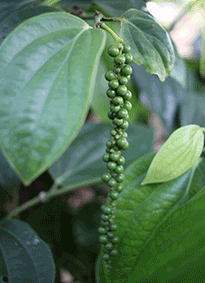 Black Pepper Vine
UT
Black Pepper Vine
UTPiper nigrum Not to Norfolk Island, NT, SA, TAS or WA Black pepper is a tropical vine and prefers warm, moist conditions over the summer. In cold areas that experience frost it is best grown in a container and moved to a sheltered position during winter, another option is to grow it a large hanging basket. Growth will slow over the winter or during the dry season, so less water is required. The vigorous climbing vine can reach up to 4 metres long and requires support for its aerial roots. It needs a position with partial shade and protection from the hot afternoon sun. Overhead irrigation is recommended for good pollination at flowering time. The soil should be rich, moist and well-drained. Peppercorns can be harvested at different stages to provide green, black or white pepper. Provided as tubestock. GB135 |
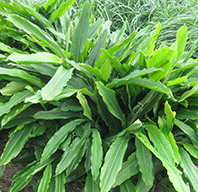
 Cardamom Leaf Ginger
UT
Cardamom Leaf Ginger
UTAlpinia nutans Not to Norfolk Island, NT, SA, TAS or WA Syn. shellflower, dwarf cardamom, false cardamom. Cardamom Leaf Ginger is one of the hardiest members of the ginger family with a wide range of uses. The plant forms good-sized clumps fairly rapidly and can be used as a 1 m tall screen. The evergreen foliage is attractive and can be used to create a tropical feel. The leaves have a very distinctive cardamom fragrance when crushed, although this is not the plant that produces the cardamom pods. Use the leaves in desserts; to add flavour to steamed rice, or to wrap fish. In a herbal tea they are delicious combined with lemongrass and ginger. The flowers are white, shell-like sprays and bloom prolifically. They are considered edible and can be used in salads or preserved in sugar to decorate cakes.The plants are surprisingly drought tolerant and resistant to pests and diseases. It will grow in full sun but prefers partial shade. One of our favourite uses is to cut and gather armfuls of fragrant leaves for mulching. Provided as tubestock. GC136 GC137Save $1.90 |
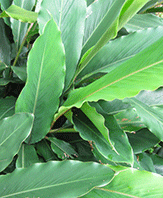 Cardamom - True
UT
Cardamom - True
UTElettaria cardamomum Not to Norfolk Island, NT, SA, TAS or WA Cardamom is a member of the ginger family and native to tropical regions. It is a tall growing, to 3 m high, perennial spice plant that forms a very large clump over time. It does not tolerate very cold conditions or frost. Cardamom likes to grow in filtered light with regular watering. It prefers a rich, mildly acidic, loamy soil. The fresh leaves can be used to flavour rice but the main harvest is the small green seedpods containing one of the world's most expensive spices by weight. The spice is a common ingredient in Indian and Scandinavian cooking. In the Middle East it is used as a traditional flavouring in coffee and tea. Time to harvest: 3 years to produce seed pods. Provided as a rhizome per pack. GC123 |
 Galangal 'Monkey Puzzle'
UT
Galangal 'Monkey Puzzle'
UTAlpinia galanga Not to Norfolk Island, NT, TAS or WA Syn. Thai ginger, laos, greater galangal, galingale, kha. An attractive foliage plant with spikes of small white flowers that grows best under trees in a moist position. The roots are large and white and used like ginger in Thai cooking but with a greater fragrance. Young shoots can also be steamed and eaten. Suitable for warm temperate to tropical areas. More info on growing galangal... Provided as a rhizome per pack. GG121 Provided as tubestock. Not to Norfolk Island, NT, SA, TAS or WA GG171 GG172Save $1.90 |
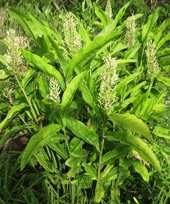
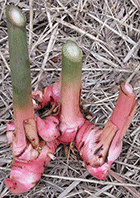 Galangal 'Red'
UT
Galangal 'Red'
UTAlpinia galanga Not to Norfolk Island, NT, TAS or WA Syn. Thai ginger, laos, greater galangal, galingale, kha. Attractive foliage plant that will grow under trees in a moist position. The roots have a distinctive reddish colouring and are used like ginger in Thai cooking but with a greater fragrance. Young shoots can also be steamed and eaten. Suitable for warm temperate to tropical areas. More info on growing galangal... Provided as a rhizome per pack. GG127 GG128 Provided as tubestock. Not to Norfolk Island, NT, SA, TAS or WA GG129 GG140Save $1.90 |
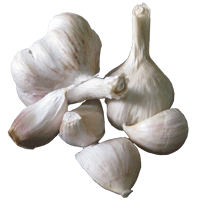 Garlic 'Glenlarge'
OG
Garlic 'Glenlarge'
OG
Allium sativum Artichoke Group Not to Norfolk Island, NT, TAS or WA Good choice for warm climates Garlic 'Glenlarge' is a soft-neck type with a purple skin, selected by Gatton Research Station as being suitable for Australian conditions, from the Atherton Tableland to SA. It is a top-setting, early, day-length neutral garlic, which makes it far more suitable for warmer areas, than many other garlic cultivars. Each bulb weighs approximately 37 g; there is an average of 11 planting pieces (large cloves) per bulb; with an average of 27 bulbs per kg. More info on growing garlic... GG105 SOLD OUT FOR 2023 GG106 SOLD OUT FOR 2023 If you live from North of Brisbane we also highly recommend you plant Italian Pink |
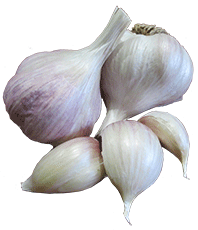 Garlic 'Italian Pink'
UT
Garlic 'Italian Pink'
UTAllium sativum Artichoke Group Not to Norfolk Island, NT, TAS or WA Good choice for warm climates Garlic 'Italian Pink' is a soft-neck type with a pink-purple skin and medium bulb developed by the Gleeson family of WA. It is an Artichoke type adapted to wide variety of climates. A day-length neutral garlic that does not like very cold, wet winters. It is one of the main types grown commercially in WA, northern NSW and QLD. The flavour is very good, rich, sweet and spicy, with moderate hotness. The flavour improves if the bulbs are kept for a few weeks after curing and before use. Each bulb weighs approximately 44 g; there is an average of 10 to 12 planting pieces (large cloves) per bulb; with an average of 25 bulbs per kg. More info on growing garlic... GG160 SOLD OUT FOR 2023 GG161 SOLD OUT FOR 2023 If you live from North of Brisbane we also highly recommend you plant Glenlarge, which has been selected by researchers for QLD. More info: https://www.australiangarlic.net.au/garlic/subtropical-group/glenlarge |
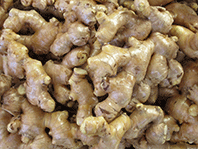 Ginger 'Jumbo'
UT
Ginger 'Jumbo'
UTZingiber officinale Not to Norfolk Island, NT, SA, TAS or WA Syn. keong, khing, gung, halia, jahe, luya, shooga. Very easy to grow for a year round supply in frost-free areas. We plant in spring and harvest in autumn to avoid our cold winter. It is a shade-loving perennial herb native to the tropics and likes moisture. More info on growing ginger... Provided as tubestock. GG180 |
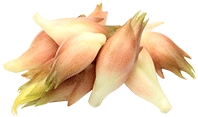 Ginger - Myoga
Ginger - Myoga
 UT
Rare
UT
RareZingiber mioga Not to Norfolk Island, NT, TAS or WA Syn. Japanese ginger. Myoga ginger is a perennial rhizome native to Japan, Korea and China. The leafy stems grow to 1 metre high with wide green leaves, similar in appearance to turmeric. Beautiful orchid-like pale yellow flowers bloom in autumn at ground level. In spring the spicy young shoots are harvested and used like the flower buds. The flower buds are used as a garnish, in soups, tempura, pickled and as a spice. Myoga requires a rich moist soil and the partial shade of its natural woodland habitat. It is the cold hardiest of the gingers and frost tolerant, especially if well mulched. It dies back in winter and will reshoot in spring. Suitable for subtropical and temperate areas. More info on growing ginger... Provided as a rhizome per pack. GG158 Provided as tubestock. Not to Norfolk Island, NT, SA, TAS or WA GG156 |
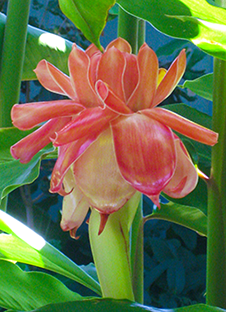 Ginger - Pink Torch
Ginger - Pink Torch
 UT
UTEtlingera elatior Not to Norfolk Island, NT, SA, TAS or WA This beautiful edible flower is really too pretty to eat but if you want to try, it is picked it at the bud stage. The buds have piquant, ginger-like flavour and add vibrant colour sliced as a garnish or used thinly sliced in a salad. The young, tender edible leaves are cooked with rice and the fruits are candied. It is a perennial tropical plant that can grow quite large to 3 - 5m high and spreads as a clump. The gorgeous, large, waxy pink flowers appear in summer. The entire shape of the bloom and flower stalk is said to resemble a torch, hence the plant's common name. It prefers a warm, humid climate but will grow as far south as Sydney in a sheltered microclimate. It will grow from full sun to partial shade in a protected position and requires moist, well-drained soil, rich in organic matter. The flowers are popular in floral arrangements, as well as in cooking for their sour-sweet flavour. The edible torch gingers are commonly called Bunga Kantan in Malaysia. More info on growing ginger... Provided as a rhizome per pack. GG100 |
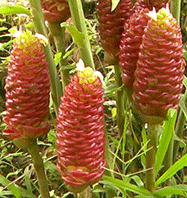 Ginger - Puyang
Ginger - Puyang
 UT
UTZingiber aromaticum Not to Norfolk Island, NT, SA, TAS or WA This shade-loving, ginger species grows to about 1.5 m. It is ornamental, with small yellow flowers appearing on striking red cones produced at the base of the plant. It is cultivated in Indonesian kitchen gardens, the tips of the young rhizomes, young leaf shoots and the yellow flowers are eaten raw or cooked with rice or used as a flavouring. The rhizome is fibrous, strongly aromatic and used medicinally. More info on growing ginger... Provided as a rhizome per pack. GG143 Provided as tubestock. GG169 |
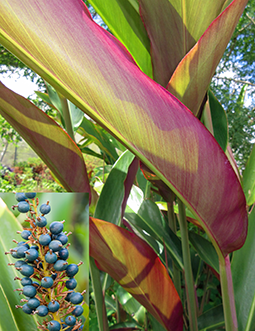 Ginger - Red Back
Ginger - Red Back
 UT
UTAlpinia caerulea Syn. native ginger. Not to Norfolk Island, NT, SA, TAS or WA This hardy, native ginger has lush, glossy-green leaves with attractive burgundy undersides. Both the leaves, bright blue berries (but not the seeds) and rhizomes are all edible and mildly ginger flavoured. It forms a clump 2 metres high and 2 metres wide. Small, fragrant white flowers appear from late spring to early summer. It is a native understorey in rainforest so prefers a warm, humid climate but will grow as far south as Sydney in a sheltered microclimate, it doesn't tolerate frost. It prefers a shady spot in a protected position and requires moist, well-drained soil, rich in organic matter. Provided as tubestock. GG198 GG199Save $1.90 |
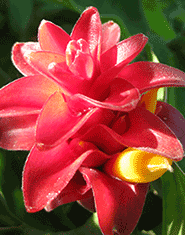 Ginger - Red Tower
Ginger - Red Tower
 UT
UTCostus comosus Not to Norfolk Island, NT, SA, TAS or WA Red Tower Ginger is ornamental and has edible flowers. The deep red bracts wrap around a bright yellow flower that can be thinly sliced and added to salads, it has a spicy ginger flavour with citrus overtones. The leaves are emerald green with an attractive spiralling appearance. It grows to 2.5 m high and can form a large clump, with flowering nearly year-round, both from the tops of the stems and from basal stems. It is surprisingly cold tolerant and will grow in most areas of Australia. Provided as a rhizome per pack. GG201 Provided as tubestock. GR141 GR142Save $1.90 |
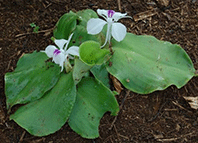 Kencur
UT
Kencur
UTKaempferia galangal Not to Norfolk Island, NT, SA, TAS or WA Syn. cekur, aromatic ginger, sand ginger, cutcherry, resurrection lily, sha jiang. Kencur is a rare, tropical, low growing perennial in the ginger family with very pretty, white and purple flowers produced at ground level. It has tuberous roots and rounded green spreading leaves. It is native to India and widely cultivated in China, Malaysia, Thailand and Indonesia. The fresh rhizomes and young shoots are pickled, eaten raw or cooked as vegetables. The roots are pounded to make an essential ingredient of Indonesian satay sauce. In Malaysian cooking the roots and leaves are used in curry paste for fish and the young leaves are eaten raw as a vegetable. It grows well in the tropics and subtropics; in temperate areas it would need to be grown in a glasshouse. It prefers a shady spot in a protected position and requires moist, well-drained soil, rich in organic matter. Provided as a rhizome per pack. GK113 Provided in mini pots. GK110 GK111Save $1.90 |
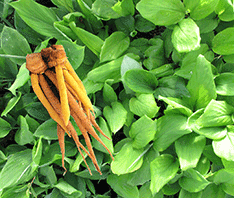 Krachai / Chinese Keys
UT
Krachai / Chinese Keys
UTBoesenbergia rotunda formerly P. pandurata Not to Norfolk Island, NT, SA, TAS or WA Syn. Chinese keys, kachai, kunci. Krachai belongs to the ginger family and is widely cultivated in Indonesia and Thailand for the aromatic, spicy flavour of its rhizome. It is used raw in salads, added to soups and curries especially those made with seafood. It dies back in winter and will reshoot in spring, growing to about 60 - 90 cm in height. Krachai requires a rich moist soil and partial shade. Suitable for subtropical and temperate areas. More info on growing krachai syn. Chinese Keys Provided as tubestock. GK102 GK107Save $1.90 |
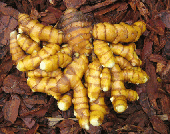
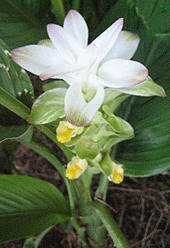 Turmeric 'Madras'
UT
Turmeric 'Madras'
UTCurcuma domestica Not to Norfolk Island, NT, TAS or WA Syn. Indian saffron, ukon, nghe, wong-keong. Turmeric 'Madras' is a deep orange, excellent quality, culinary turmeric. A shade-loving hardy, perennial herb with a beautiful white flower spike. The root can be used fresh like ginger or dried and ground for curry powder. It has long been used in both Chinese and Indian medicine; recent research has shown that it is beneficial in the treatment of many different health conditions. Turmeric was traditionally called Indian saffron and it is also used as a textile dye. Suitable for warm temperate to tropical areas. More info on growing turmeric... Provided as several rhizomes per pack. GT112 Provided as tubestock. Not to Norfolk Island, NT, SA, TAS or WA GT109 GT116Save $1.90 |
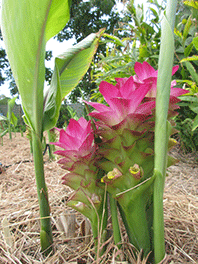 Turmeric - Temulawak
UT
RARE
Turmeric - Temulawak
UT
RARECurcuma zanthorrhiza Not to Norfolk Island, NT, TAS or WA Syn. Javanese ginger. A shade-loving, hardy, beautiful plant that looks very similar to Cape York Turmeric Curcuma australasica but has a darker pink flower. Often used medicinally as it has a high percentage of curcumin. The root can be used fresh like turmeric or dried and ground as a spice. Suitable for subtropical and tropical areas. More info on growing turmeric... Provided as a rhizome per pack. GT126 Provided as tubestock. Not to Norfolk Island, NT, SA, TAS or WA GT144 |
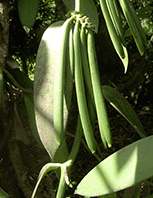
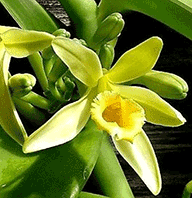 Vanilla Bean
UT
Vanilla Bean
UTVanillla planifolia Not to Norfolk Island, NT, SA, TAS or WA Syn. vanilla orchid. Real vanilla is a popular spice and the only edible fruit of a climbing orchid. It is a tropical plant native to Mexico and in its native rainforest habitat would climb up into trees, 2 - 5 metres high. The orchid flowers need to be hand-pollinated to produce pods which then take 9 months to develop. It needs support to grow on and a sheltered environment with protection from winds. It prefers to grow in bright light and dappled shade, some morning sun is good. It prefers a rich, organic, well-drained soil with a neutral pH 6.6 - 7.5 and to be well-mulched. If growing it in a container or hanging basket then an orchid mix works best. In cooler climates it can be grown in a greenhouse. Suitable for subtropical and tropical areas. Doing a bit of web research into growing techniques, hand pollination and how to ferment the pods is a good idea as this is a complex plant to grow successfully. Provided as tubestock. GV113 |
|
Green Harvest specialises in plants which are:
|
Not to NORFOLK ISLAND, NT, SA, TAS or WA
SORRY but due to quarantine restrictions between Australian States no plants at all can be ordered by residents of Norfolk Island, Tasmania and Western Australia. These restrictions are very important as they prevent the spread of plant pests and diseases. No potatoes, garlic, shallots, strawberries or tubestock can be sent to South Australia. No tubestock can be sent to Northern Territory.
SORRY but due to quarantine restrictions between Australian States no plants at all can be ordered by residents of Norfolk Island, Tasmania and Western Australia. These restrictions are very important as they prevent the spread of plant pests and diseases. No potatoes, garlic, shallots, strawberries or tubestock can be sent to South Australia. No tubestock can be sent to Northern Territory.
 Home
Home
Green Harvest Organic Gardening Supplies is permanently closed as of 5pm on 1-11-2023.
We will not be taking orders by this website, in person, by phone or email. Our display garden and retail shop are closed forever.
Read more...
Phone:07 54357000
Phone calls will only be responded to sporadically and only in reference to orders placed prior to 2-11-2023. All the useful growing and organic pest management research and resources are available on this website for a while still.
No liability will be accepted by Green Harvest, its owners or employees as to the accuracy of any information. No responsibility will be taken for damage to property or persons due to information given about a product or technique. No responsibility will be taken for the loss of a crop or income due to information given about a product or technique.
 Shopping here is private and secure.
Shopping here is private and secure.
Copyright © 2001 - 2024 Green Harvest Organic Gardening Supplies
No part of this website may be reproduced without permission of the owner

